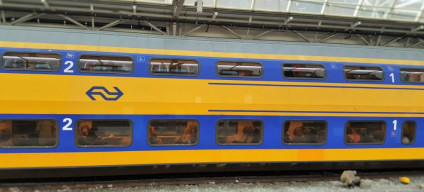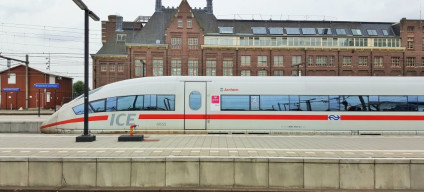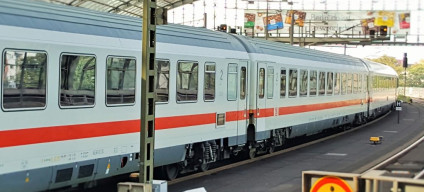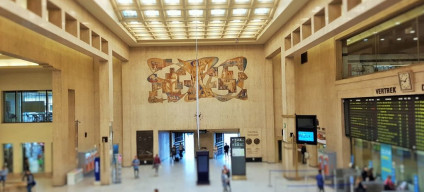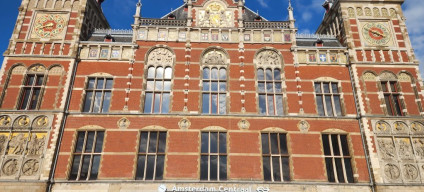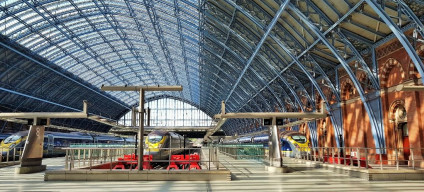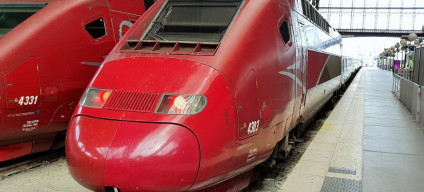Related Content
Content

Netherlands by train
Welcome to the guide on how to save money, time and confusion when travelling in and from/to The Netherlands by train.
Share
NS is the national rail operator in The Netherlands and how it operates the rail network makes exploring The Netherlands by train comparatively simple.
Frequent trains link often spectacular stations, which are public transport hubs for the delightful cities and towns that they serve.
Ticketing for the national network is also comparatively straightforward and if you have a rail pass, you can use it to hop on and off trains to see multiple cities in a single day.
Timetable changes for 2025
On the new timetable, NS has made significant changes to its InterCity Direct services which use the high-speed lines between Amsterdam and Rotterdam; and between Rotterdam and Breda / the Dutch border.
The new service pattern is:
- Amersfoort Schothorst - Amersfoort - Amsterdam Zuid - Schiphol Airport - Rotterdam - Breda; 2 x trains per hour
- Lelystad - Almere - Amsterdam Zuid - Schiphol Airport - Rotterdam; 1 x train per hour
- (Lelystad - Almere) - Amsterdam Zuid - Schiphol Airport - Rotterdam - Antwerp - Bruxelles; 1 x ECD train per hour
Note that these InterCity Direct (ICD) services no longer operate on the Amsterdam Centraal ↔ Rotterdam route.
The Netherlands ↔ Belgium
The introduction of the ECD services is part of a transformation of the long-standing service pattern between the Netherlands and Belgium.
In summary the long-distance cross border service is now:
- Amsterdam Centraal - Rotterdam - Antwerp Centraal - Bruxelles-Midi - Paris by Eurostar
- Amsterdam Centraal - Rotterdam - Bruxelles-Midi - London by Eurostar
- (Lelystad - Almere) - Amsterdam Zuid - Schiphol Airport - Rotterdam - Antwerp - Bruxelles-Midi; 1 x Eurocity Direct (ECD) train per hour
- Rotterdam - Breda - Antwerp Centraal - Antwerp Berchem - Mechelen - Bruxelles Airport - Bruxelles Nord - Bruxelles Central - Bruxelles Midi; 1 x EuroCity (EC) train per hour.
Links to Useful Info

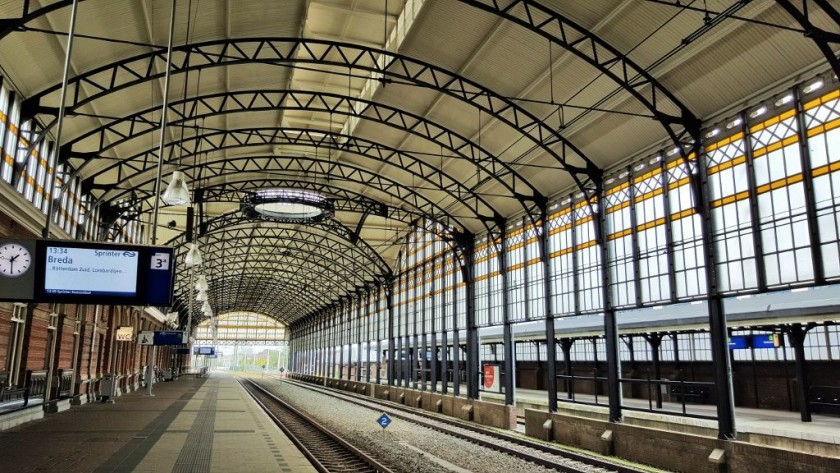
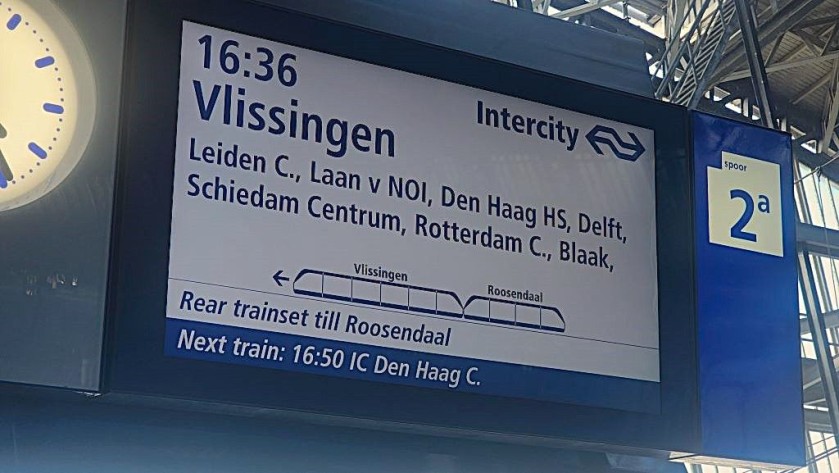
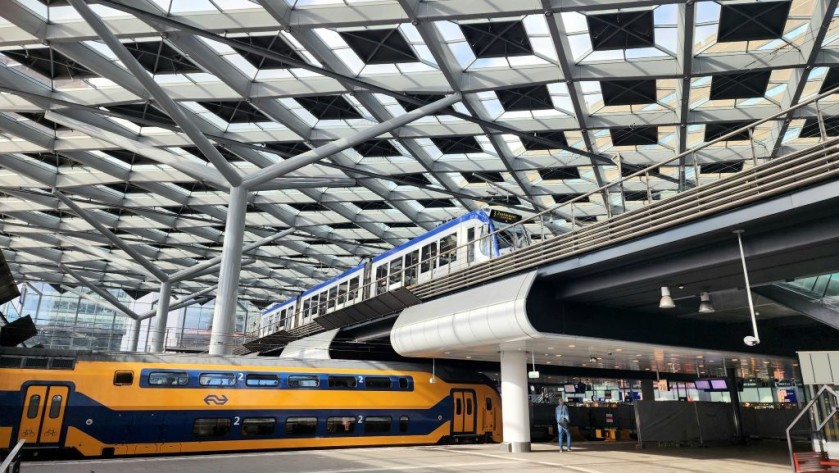
The 16 Things Most Worth Knowing...
These are the sixteen things that are particularly useful to know about rail travel in The Netherlands:
- Train services tend to operate to a fixed timetable (departing at the same minutes of each hour) with all IC express train routes operating at a minimum of 1 x train per hour - but 2 x trains per hour is the norm on many routes.
- The trains on routes solely within The Netherlands have no on board catering facilities.
- Seat reservations are not available on national train services that operate wholly in The Netherlands.
- The on board experience is different on the international train services, by Eurostar to/from Belgium, London and Paris; and on the IC and ICE trains to/from Germany - it isn't possible to travel between Dutch stations on the Eurostar trains.
- The ticket terms, including whether seat reservations will or won't be included, also differ on the international trains - hence a dedicated booking service for journeys to and from The Netherlands, which is branded NS International.
- Discounted tickets are not available for journeys within The Netherlands, so you will pay the same price if you book last minute at the station.
- If you do buy tickets at the station there is a €0.50 service charge if you use a ticket counter, but you don't pay this charge if you use a ticket machine.
- The prices of long-distance train tickets in The Netherlands are based solely on distance travelled; which sounds like we're stating the obvious, but this is actually unusual in Europe.
Therefore all regular NS departures are charged at the same price, meaning that you won’t have to pay a premium to travel on particularly popular trains, or when travelling at peak times. - The InterCity Direct services are exceptional, as they require a supplement to be paid for journeys which use the 'high-speed' Schiphol - Rotterdam line,
- For children aged 4 - 11 you need to purchase 'Railrunner' ticket but they cost only €2.50 per child and 'Railrunners' are valid for the whole day.
- Children aged 12 and over have to travel at the adult rate.
- Dutch stations are gated, so tickets and passes have to be placed on the glass panels to open them when heading to and from the platforms used by the trains.
- Most of the larger Dutch stations have long platforms/tracks (sporen) which are divided into sections (not zones) and trains tend to depart from a specific section of the spoor/track/platform - ‘8a’ or ‘8b’ etc.
- Amsterdam Centraal/Amsterdam C station isn’t the hub of the Dutch rail network - instead many trains to and from the city use Amsterdam Zuid station, which is located to the south of the tourist heart of the city, in the business district.
- Non-folding bikes can only be taken on NS trains if you purchase a day ticket for bikes also known as a 'Bicycle Card Dal'.
- Particularly in North and South Holland the faster InterCity trains share routes with stopping trains, but these stopping trains are somewhat confusingly designated Sprinter.
So avoid hopping on a 'Sprinter' because it is the next train to leave.
It's likely that a later InterCity service will actually get you to your destination quicker.
Travelling on Dutch trains:
Dutch trains operated by NS are functional rather than fabulous, but with journey times rarely exceeding two hours, this isn’t a problem.
It's also why reservations are not available on national train services that operate wholly in The Netherlands; which is a plus for rail pass users who can hop on and off any of these trains.
Wi-fi is available on all express InterCity (IC) trains and the Intercity Direct trains
It's also available on the newer trains used for the local Sprinter services.
You can also access Wi-fi on the international ICE and Thalys services in The Netherlands.
Note that trains operated by NS on routes solely within The Netherlands also have no on board catering facilities.
Something else to watch out for is that on the outside of some Dutch trains, the button that opens the door can be an arm’s length from the door itself.
The timetable:
Train services tend to operate to a fixed timetable (departing at the same minutes of each hour) with all IC train routes operating at a minimum of 1 x train per hour
Within the most populous Randstad area (the area around Amsterdam, The Hague, Rotterdam and Utrecht) trains services operate at least every 30 mins on all routes.
Something to be aware of is that Amsterdam Centraal/Amsterdam C station isn’t the hub of the Dutch rail network.
Instead many trains to and from the city use Amsterdam Zuid station, which is located to the south of the tourist heart of the city, in the business district.
As a result from some locations a change of train is required when travelling to Amsterdam C station, but these and other connections are built into the timetable.
Intercity trains are very rarely more than 10 mins late.
Going long-distance:
When travelling between cities, the fastest options are the InterCity (IC) trains, so it’s worth looking out for these
It's because the Dutch national rail operator NS, uses a generic ‘InterCity’ branding for its express trains that skip stations.
Particularly in North and South Holland the faster InterCity trains share routes with stopping trains, but these stopping trains are somewhat confusingly designated Sprinter.
So avoid hopping on a 'Sprinter' because it is the next train to leave.
When going longer distances, it's usually likely that a later InterCity service will actually get you to your destination quicker.
Though a plus of taking the Sprinter trains is that they have level, step-free boarding - but a couple of steps have to be used when boarding and alighting from the InterCity trains.
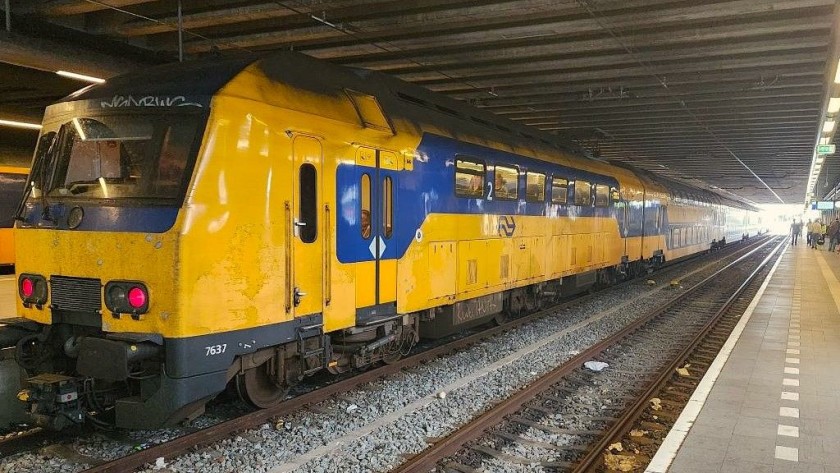

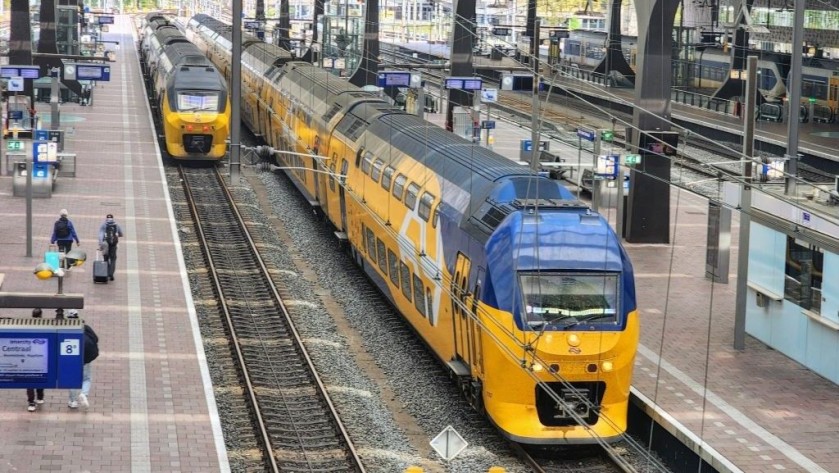
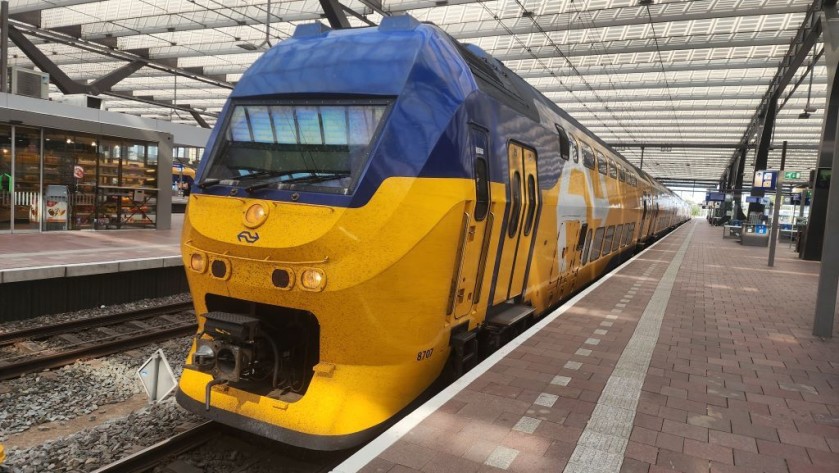
There are multiple types of trains that NS uses on its Intercity services and specific types of train are usually allocated to each route.
Hence some routes are served by the iconic double deck trains, while others have the single deck trains
Some longer distance InterCity trains can skip stations that other InterCity services, on shorter routes, call at.
While on the sections of the longer InterCity routes furthest from Amsterdam and Rotterdam, some InterCity services call at virtually all stations and in effect become the local trains.
the InterCity Direct services:
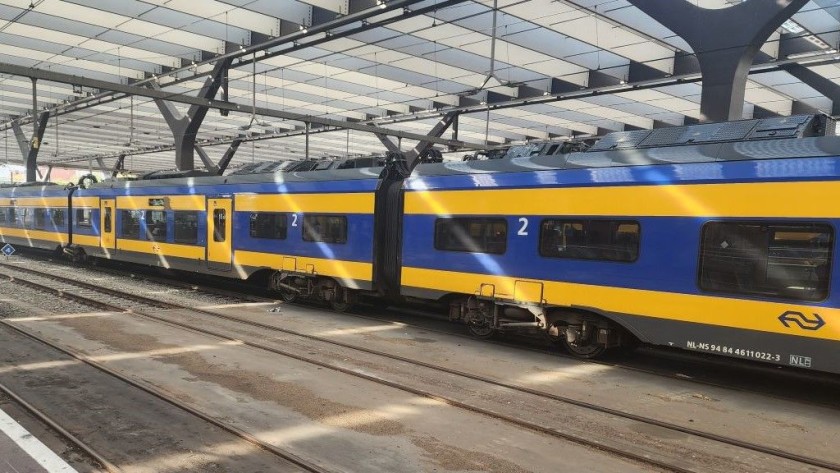
The InterCity Direct services are exceptional as they use the Dutch high speed lines between Rotterdam and Bredal and between Rotterdam and Schiphol Airport.
New single-deck trains with level boarding have also been introduced to these services / routes.
When travelling between Schiphol and Rotterdam they require a supplement to be paid to travel by them, because they are exponentially faster than the alternative trains that still take the older, 'classic' route via Delft and Leiden.
Hence this supplement of up to €2.40 is now charged in both 1st and 2nd class for journeys which include:
- Amsterdam ↔ Rotterdam
- Amsterdam ↔ Breda
- Schiphol ↔ Breda
- Schiphol ↔ Rotterdam
Note that no additional payment is required when using these trains to travel between Rotterdam and Breda, Den Haag and Eindhoven
When buying a ticket for a journey by these trains, the best option is to buy an ordinary ticket for the journey.
You then have to pay for the supplement on the red 'supplement' pole which you will find on the platforms/tracks (spors) which these trains use.
The reason for using this method is if you don't travel in business hours, the price charged by these supplement machines will be reduced by €1.
If you will be travelling with a Chipkart or bank card, you need tap it against these poles (machines) prior to boarding.
Taking bicycles:
NON-FOLDING bikes can only be taken on NS trains if you purchase a day ticket for bikes also known as a 'Bicycle Card Dal'.
But there are exceptions, in particular on Mon-Friday you cannot take non-folding bikes on any train between 06:30 - 09:00 and between 16:00 - 18:30.
Bike spaces can now be booked in advance of travel.
Virtually all NS trains have specific bicycle storage areas, look for the symbols on the outside of the train.
You must use these when taking a bike on board; more info is available HERE
Detailed train guides
Click on the buttons below to access info such as on board facilities, and what to look out for when boarding and travelling with luggage/bikes.
Notes on the international trains:
There are seven international DAYTIME train services from and to The Netherlands:
1: Eurostar formerly Thalys trains operate on these routes:
- Amsterdam Centraal – Schiphol – Rotterdam – Antwerpen – Bruxelles Midi – Paris gare du Nord
- Amsterdam Centraal – Rotterdam – Lyon – Marseille (summer only)
- Amsterdam Centraal – Rotterdam - Bourg St Maurice in the French Alps (winter only)
2: Eurostar also offer a direct service from London St. Pancras to Rotterdam and to Amsterdam.
This service runs up to 4 x per day and the trains only call at Bruxelles-Midi/Brussels South on route to The Netherlands.
On the return leg (from Amsterdam and Rotterdam to London) a direct service is now also available.
3: Eurocity Direct (ECD) trains trains operate on this route: Lelystad - Almere - Amsterdam Zuid– Schiphol - Rotterdam - Antwerpen – Bruxelles Midi
4: EuroCity (EC) trains trains operate on this route: Rotterdam - Breda - Antwerpen – Mechelen - Bruxelles Airport – Bruxelles Nord – Bruxelles Central – Bruxelles Midi
5 German ICE3 trains operate on these routes:
- Amsterdam – Utrecht – Arnhem – Oberhausen – Duisburg – Dusseldorf – Koln/Cologne – Frankfurt Flughhafen/Airport – Frankfurt (Main)
- Amsterdam – Utrecht – Arnhem – Oberhausen – Duisburg – Dusseldorf – Koln/Cologne – Frankfurt Flughhafen/Airport – Mannheim – Stuttgart - Ulm - Augsburg - Munchen/Munich (1 x train per day)
6: German IC trains, which NS brands as 'Intercity Berlijn' operate on this route:
Amsterdam – Amersfoort – Deventer – Bad Bentheim – Rheine – Osnabruck – Hannover – Wolfsburg – Berlin
7: German Regional trains operate on these routes:
- Venlo – Monchengladbach – Dusseldorf – Wuppertal - Hamm
- Arnhem - Emmerich - Oberhausen - Duisburg – Dusseldorf.
New overnight services:
For many years the only overnight train service from The Netherlands was the Alpen Express.
which connects these Dutch cities - Amsterdam, Den Bosch, Den Haag, Eindhoven, Haarlem, Leiden, Utrecht and Venlo and multiple Austrian ski resorts - with an outward journey to Austria on Fridays between December 20th and March 13th and a return on Saturdays between December 21st and March 14th.
But now there are Nightjet services on three routes from Amsterdam via Utrecht and Arnhem
- to Munich/Munchen and Innsbruck
- Linz and Wien/Vienna
- to Basel and Zurich.
Journeys from Amsterdam
The journey guides include access to booking links and information about the trains, tickets and destination stations. Plus for the scenic routes there are insights on how to make the most of the rides on the trains.
Using major stations in The Netherlands
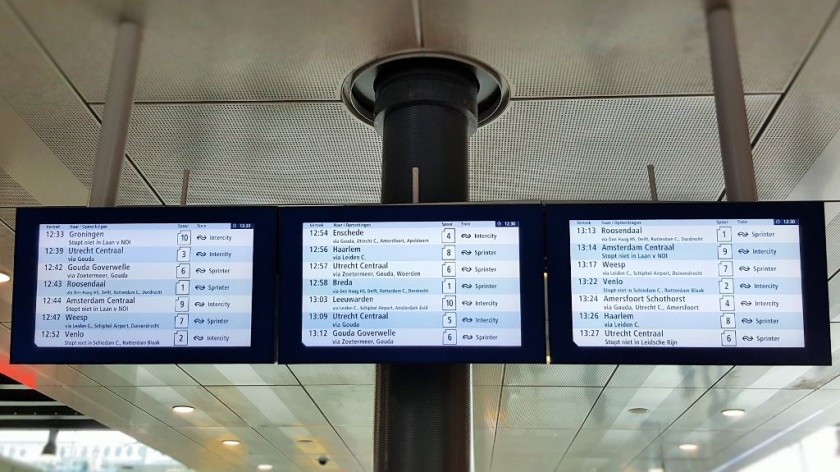
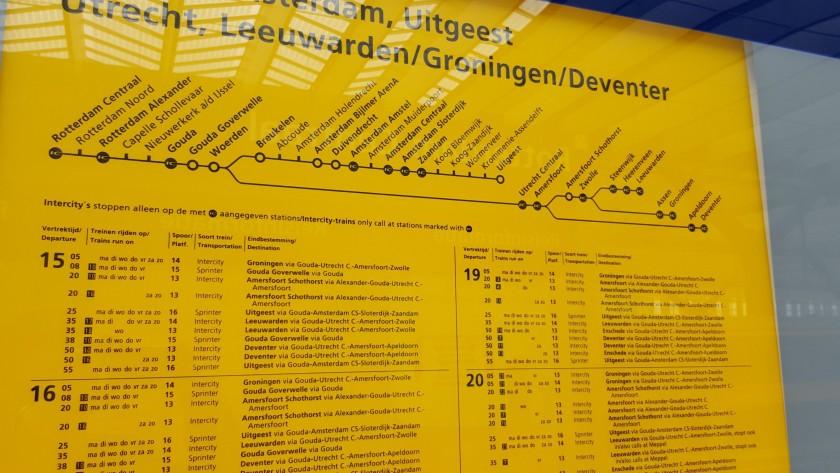
Nine things which are good to know about the larger Dutch stations:
1: The main stations in The Netherlands do not have the type of large electronic departure boards that can be typically found on the main concourse in other countries.
Instead departures are listed solely on the smaller TV style screens that will be located around the station.
However, at busy stations only the trains departing within the next 10-15 minutes may be shown.
2: These information screens in the departure halls only show the terminating station AND the principle stations that the train will be calling at (‘via Delft, Leiden’ etc).
3: On all departure information screens, if a train is terminating at Amsterdam Centraal (the city’s main station) ‘Amsterdam Centraal’ is displayed.
However, if a train is calling at Amsterdam Centraal on route to somewhere else, then ‘Amsterdam C’ is displayed.
4: The main info screens on the platforms/tracks (sporen) which show the next train to depart DO list all the stations that a train will be calling at.
It will be shown as scrolling text next to 'via'.
5: Dutch stations also don’t have paper departure sheets that list all trains consecutively.
Instead each route has its own dedicated departure sheet, the station that you will be travelling to, will be listed on one of these sheets.
However, the main stations therefore have multiple departure sheets, as they have multiple routes passing through them.
So if you’re not familiar with the routes, finding your station on these sheets, to discover the times of subsequent trains can be tricky, but staff at the info/reservation desk or ticket office will be able to help.
6: Most of the larger Dutch stations have long platforms/tracks (sporen) which are divided into sections (not zones)
Trains tend to depart from a specific section of the spoor/track/platform - ‘8a’ or ‘8b’ etc.
If you are new to Dutch train travel, make sure you don't mix them up.
7 The platforms/tracks/sporen on Dutch station platforms usually aren't zoned in terms of wait in Zone A for coaches 1 to 3 etc.
That's because with reservations not possible on domestic train services, there's little point in directing travellers to wait in specific areas on a spoor/platform.
However, as a result people tend to gather around the entrance points to a spoor/platform, particularly around the departure indicators.
So a tip is to move away from the crowds; as reservations aren't possible on NS trains, there can be a scramble to board particularly busy trains.
But avoid straying too far, because a quirk of IC trains is that most are formed of 8 -12 carriages/coaches, but some have only 4.
And when 4 coach trains are used, a dash along the platform/spoor in order to board the train is often inevitable.
At the stations used by international trains there are now zones, but this zone info is typically only used for the international trains; the Eurostar, ICE, Thalys,, IC to Germany and Nightjets, as these trains have numbered coaches.
So you can use the zone info to locate a specific coach in which a reserved seat or bed is located, as this zone info is used on the departure screens for these trains.
8: Virtually all Dutch stations are gated, meaning that you have to pass through a gate/barrier to access the platforms/sporen.
The gates are opened by scanners that read barcodes, you don’t insert tickets.
9: Though something to be particularly aware of is that tickets aren't required to open the gates, they can also be opened by using bank debit cards, mobile phones linked to mobile bank accounts and by OV-Chipkaarts.
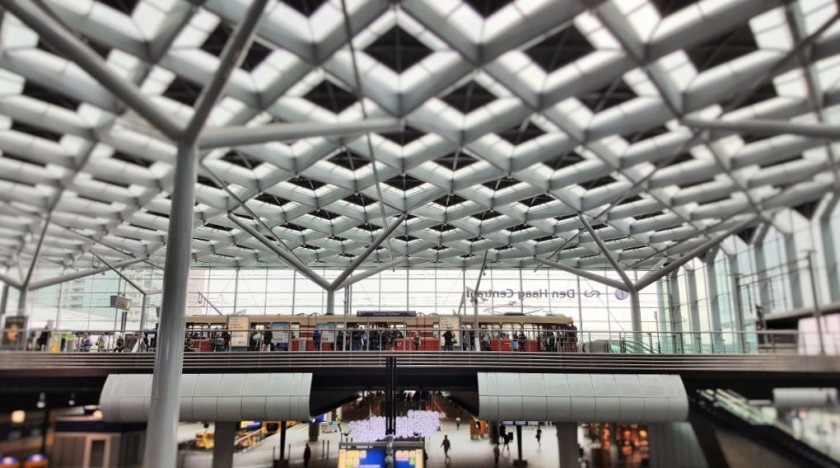
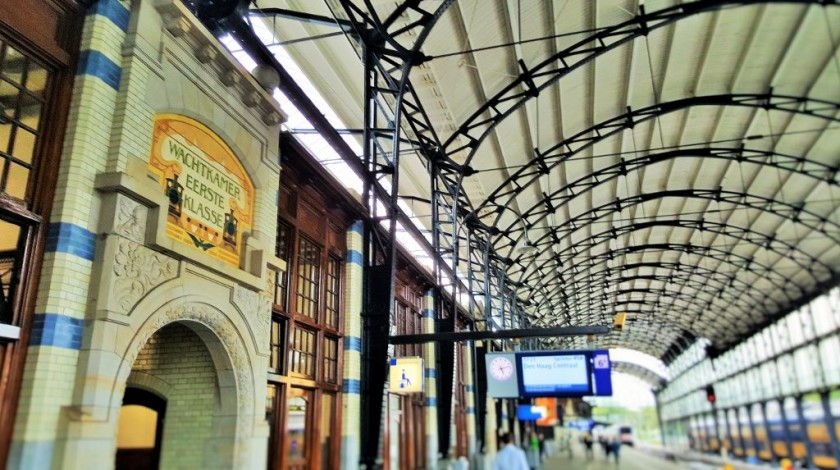
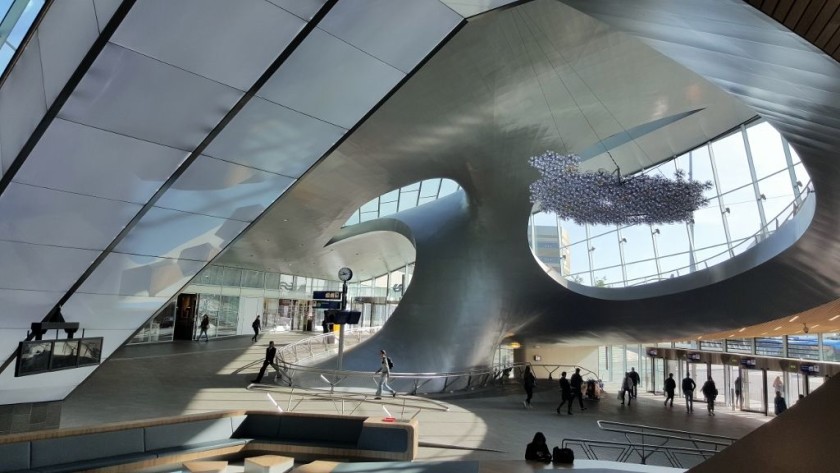
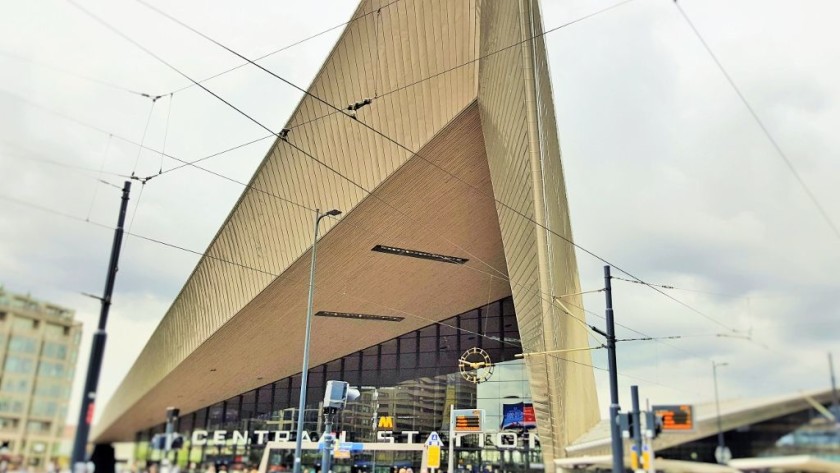
the main station in Rotterdam
Notes on the ticketing:
Six Things That Are Good to Know about Dutch train tickets:
1: Discounted tickets are not available for journeys WITHIN The Netherlands; neither are they available on the Regio trains to Germany.
Therefore there is no need to book tickets for domestic journeys solely within The Netherlands online, they will cost the same if booked at the station.
Though if you use a ticket counter you will have to pay a €0.50 service charge.
2: NS ticket machines have excellent English translations, but they only accept cards and coins, not notes.
3: Ticket gates at stations have to be opened and closed when heading to and from trains, but the gates can be opened by tapping the reader with:
- tickets; purchased at machines or ticket counters; a $0.50 surcharge is payable at the ticket counters,
- bank debit cards,
- payment apps installed on mobile devices' *see the note below
- travel cards and passes including One Day Tickets and Holland Travel Tickets,
- OV-Chipkaarts, the national multi public transport travel card, which can be topped up at ticket machines.
4: So there is no need to 'buy tickets' at the station, no matter the distance being travelled, as bank card and payment apps can be used to open the ticket gates and the charge for the journey will be applied when you tap out on arrival at the destination.
Why use the machines / counters to obtain tickets?
- If you want to travel 1st class on IC train - if you tap the gates with cards and apps you can only travel in 2nd class
- If you want to use only one bank card to pay for multiple people taking the same journey together, you can only do this at the ticket machines or counters.
5: If you will be buying a ticket for a journey that requires a change of train, then it’s a good idea to use a ticket office.
You can then enquire about how to make the connection at the station, where you will have to change.
6: Have your passport with you, even when making journeys solely within The Netherlands.
If a ticket inspection is carried out on the train you may be asked for an I.D. document.
Using travel cards instead of tickets:
The majority of Dutch people use travel cards instead of buying tickets.
Known as 'OV-Chipkaarts' they're sold online by NS online here or at stations and can be used by visitors.
They can be used on the bus, tram and metro as well as the trains!
Discounted Day tickets
The Holland Travel Ticket is in effect a one-day national travel pass that can be used by visitors to The Netherlands.
It covers all public transport including the trains, metro / subways, trams and buses.
The Off Peak version is cheaper, but it can't be used in the mornings between 06:30 and 09:00.
Staying in or near Amsterdam
You can use the Amsterdam Region Travel Ticket for unlimited travel by train (2nd class) between any of the following stations in Amsterdam and the Amsterdam region:
Almere: (Almere Buiten, Almere Muziekwijk, Almere Oostvaarders, Almere Parkwijk, Almere Poort), Amsterdam: (Amsterdam Amstel, Amsterdam Bijlmer ArenA, Amsterdam Centraal, Amsterdam Holendrecht, Amsterdam Lelylaan, Amsterdam Muiderpoort, Amsterdam RAI, Amsterdam Sciencepark, Amsterdam Sloterdijk, Amsterdam Zuid), Beverwijk, Bloemendaal, Bussum Zuid, Diemen, Diemen Zuid, Driehuis, Duivendrecht, Haarlem, Haarlem Spaarnwoude, Halfweg-Zwanenburg, Hilversum: (Hilversum, Hilversum Media Park, Hilversum Sportpark), Hoofddorp, Koog aan de Zaan, Lelystad Centrum, Naarden-Bussum, Overveen, Purmerend: (Purmerend, Purmerend Overwhere, Purmerend Weidevenne), Santpoort: (Santpoort Noord, Santpoort Zuid), Schiphol Amsterdam Airport, Uitgeest, Weesp, Zaandam, Zaandam Kogerveld, Zaandijk Zaanse Schans, Zandvoort aan Zee.
There are versions valid for 1 Day, 2 Days and 3 Days and the ticket is also valid on all trams, buses, night buses, metros and ferries run by the Amsterdam transport company GVB, EBS, Keolis and Connexxion in Amsterdam and the Amsterdam region - which is in effect the public transport network in Amsterdan.
Child tickets:
For children aged 3 and under there is free travel, but the child must not occupy a seat to themselves.
For children aged 4 - 11 you need to purchase 'Railrunner' tickets for children in this age group, but they cost only €2.50 per child and 'Railrunners' are valid for the whole day.
So you don't need to buy separate 'Railrunner' tickets for each journey.
Children aged 12 and over have to travel at the adult rate.
International tickets:
In contrast to tickets for journeys WITHIN The Netherlands, discounted tickets are placed on sale for international travel on ICE, Thalys and the IC trains to Belgium, France and Germany.
This is why NS operates a separate booking site 'NS International' for these journeys (amongst others).
Using rail passes:
If you will be using Eurail or Interrail passes valid for travel in The Netherlands, you can hop on any train between Dutch stations, including the InterCity Direct and ICE trains.
Eurail and Interrail passes have barcodes printed on them that in theory will open the ticket gates at stations - and for mobile pass users the main pass bar codes should also open the ticket gates.
If they don’t do so, go to a NS reservation desk and they’ll issue you with a keycard that has a barcode printed on it.
Avoid booking reservations for international trains with mandatory reservations at Dutch stations if possible - as a booking fee will be charged per reservation.
NS International does not sell these RAIL PASS reservations online.
The detailed guide to buying and using Tickets & Rail Passes:
Please support ShowMeTheJourney
This second version of ShowMeTheJourney is exciting and new, so we are genuinely thrilled that you are here and reading this, but we also need your help.
We’re striving not to let anything get in the way of providing the most useful service possible, hence a facility has been set up with DonorBox which can be used to support the running costs and make improvements.
Instead of advertising or paywalls, your financial support will make a positive difference to delivering an enhanced service, as there’s a lot of ideas which we want to make happen.
So if you have found the info provided here to be useful, please go here to say thank you.
Additional info for rail pass users:
Pan-European travel guides
The info will help you have an easier journey;
This second version of ShowMeTheJourney is exciting and new, so we are genuinely thrilled that you are here and reading this, but we also need your help.
We’re striving not to let anything get in the way of providing the most useful service possible, hence a facility has been set up with DonorBox which can be used to support the running costs and make improvements.
Instead of advertising or paywalls, your financial support will make a positive difference to delivering an enhanced service, as there’s a lot of ideas which we want to make happen.
So if you have found the info provided here to be useful, please consider saying thank you.

This is one of more than 100 train travel guides available on ShowMeTheJourney, which will make it easier to take the train journeys you want or need to make. As always, all images were captured on trips taken by ShowMeTheJourney.

